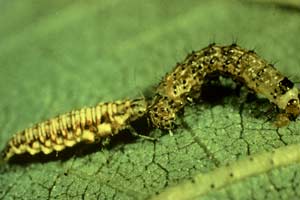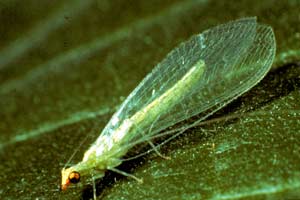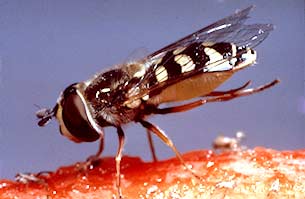Release of Lacewing Eggs
Preparing the card

Upon receiving the card, store it in a cool place (50 - 60 F.) until you are ready to begin preparing it for release. On the side the card looks like sandpaper; this is the side to which the eggs have been glued to the card.
To prepare the card for release, spread out a piece of newspaper on a table. Hold the card over the newspaper, egg side down, and cut along all the perforations. This will divide the 'card' into 'squares' and give you 30 squares. Place the cut squares into a bag or small box to take into the garden. Place the material that falls onto the newspaper into envelopes to staple to plants or sprinkle it onto low growing plants, like pansies or strawberries.
 How to release the Green Lacewing in your garden
How to release the Green Lacewing in your garden
To release the lacewings, staple one square to the leaves of infested plants or those you want to protect. It's important to place the staple so that the stapler doesn't crush the eggs, so place the staple on the unused space of the square, as shown in the diagram, to minimize any damage. It is best to place the square on the underside of a leaf , egg side away from the leaf. The young lacewing will get a meal from the square upon hatching and can go quite a distance to find their next meal, so if you can't get the square right by infestation, the hatchlings will be able to search and find the pests on their own.
The lacewing eggs should hatch in 2 to 5 days from the day you get the card. The larvae are small and spend much of their time hunting for the pest; they can be difficult to find, but you should begin to see reduced pest numbers in 10 to 20 days.
- Materials list:
- Newspaper
- Scissors
- Stapler
- Staples
- Bag or box to put the squares in for application

